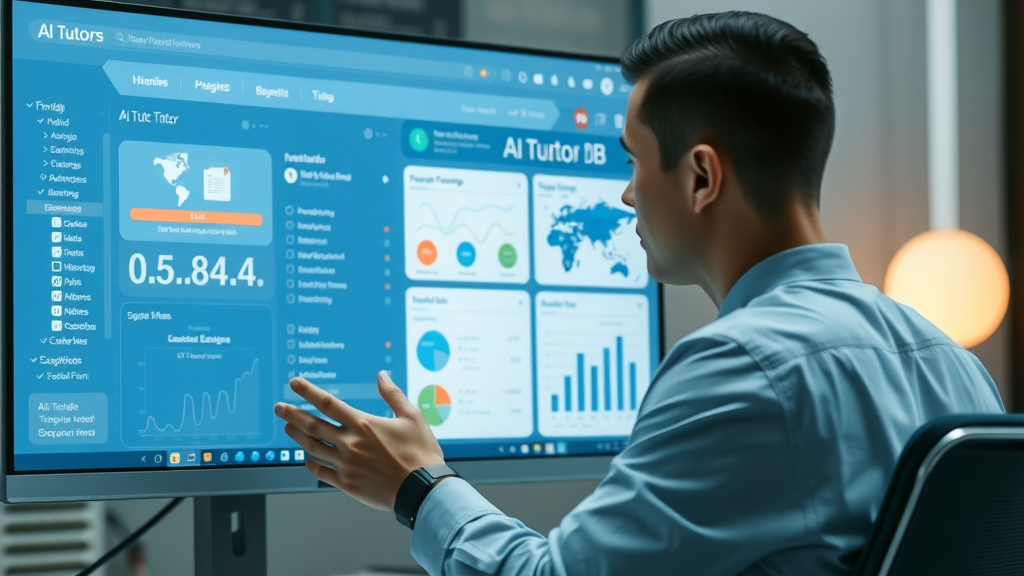Did you know that over 70% of modern learners now engage daily with artificial intelligence learning tools ? These groundbreaking platforms are rewriting the educational experience—delivering personalized learning, real-time support, and unparalleled efficiency for students and teachers alike. Whether you’re an educator, a student, or an administrator, understanding and leveraging the best AI-driven learning tools will help you unlock unprecedented growth and ensure that you stay ahead in the evolving landscape of education.

- In this comprehensive exploration, discover the essential artificial intelligence learning tools revolutionizing education, driving efficiency, and delivering personalized learning at scale.
Revealing the Power and Promise of Artificial Intelligence Learning Tools
The proliferation of artificial intelligence learning tools is sparking unprecedented change across classrooms worldwide. These tools harness AI technology to tailor content, streamline grading, prompt actionable insights, and cater to individual student needs. From adaptive modules to real-time AI assistants, the ecosystem is rich with solutions that provide valuable, personalized experiences and support every learning style.
Unlike conventional eLearning platforms, today’s AI tools offer dynamic adaptations to real-time student performance—responding instantly to gaps in understanding, adjusting difficulty, and suggesting curated resources. This evolution not only maximizes efficiency for teachers but also empowers learners to proceed at their own pace, in their most comfortable environment. Schools, universities, and even independent learners are actively benefitting from these AI-empowered upgrades.
By integrating AI tutors, machine learning algorithms, and responsive support systems, education is becoming more accessible and effective for everyone. As we dig deeper, we’ll uncover the top picks, dissect features and capabilities, and provide you with an actionable guide to the most powerful artificial intelligence learning tools available today.
A Surprising Surge: Over 70% of Modern Learners Use Artificial Intelligence Learning Tools – Here’s Why They Matter
The leap in AI learning tool adoption is a direct result of benefits that traditional methods can’t match. AI tools serve diverse learning styles through adaptive content delivery, identify weak areas instantly with real-time analytics, and give teachers the ability to save time on repetitive tasks like grading and feedback. For students, 24/7 access to AI-powered instruction means support is never more than a click away, while educators enjoy actionable insights that let them intervene sooner and more precisely.
Importantly, AI assistants and generative AI learning platforms break down barriers, ensuring equitable learning across ability levels and backgrounds. By blending data-driven personalization with interactive experiences, these platforms foster higher engagement, improved retention, and better outcomes. With such clear advantages, it’s understandable why artificial intelligence learning tools are becoming indispensable allies in modern education.

Exploring the Best Artificial Intelligence Learning Tools: A Definitive List of Top AI Tools
| AI Tool | Key Features | AI Assist & Generative Capabilities | Pricing | Differentiators |
|---|---|---|---|---|
| AI Tool X | Adaptive learning modules, real-time feedback, personalized paths | Personalized AI tutoring, generative assessments | Freemium / Subscription | Industry-leading adaptation, strong analytics dashboard |
| AI Tool Y | AI assistant, real-time recommendations, actionable insights | Dynamic content curation, teacher/student support | Subscription | Comprehensive ecosystem, seamless integration |
| AI Tool Z | Generative AI content, ML-driven assessments, chatbot support | Custom lesson generation, 24/7 AI tutor | Tiered Plans | Full-service support, advanced personalization |
1. AI Tool X: Leading the Pack in Personalized AI Tutoring
- Features: Adaptive learning modules, real-time feedback, personalized learning paths
AI Tool X stands out as a revolutionary ai tutor platform, strategically employing adaptive algorithms to personalize every student’s journey. By analyzing live performance and past results, it builds unique learning paths that match each learning style , keeps learners motivated, and ensures consistent progress. For educators, it provides valuable insights through interactive dashboards—empowering them to intervene and guide when necessary.
With real-time feedback and generative AI-driven assessments, students receive instant guidance, tailored quizzes, and clarity on weaknesses—all from a user-friendly, data-rich interface. These advanced AI tools not only help students excel academically but also encourage greater ownership over their learning experience .

AI Assist Benefits and Generative AI Capabilities
AI Tool X incorporates AI assist and generative AI capabilities that go beyond static lesson plans. Instead, its algorithms generate new exercises based on student performance, facilitating differentiated, engaging, and effective instruction. The system can adapt to spikes in student growth or stumbling blocks, ensuring learning remains personalized and productive at every stage. Through its intuitive AI interface, Tool X enables seamless communication and real-time adaptation, setting the gold standard for modern ai tutor technology.
2. AI Tool Y: The Power of Real-Time Learning with AI Assistant Functions
- Features: AI assistant integration, real-time content recommendations, actionable insights for students and educators
AI Tool Y distinguishes itself with leading ai assistant functions and real-time learning capabilities. The heart of this platform is its ability to curate and recommend content on-the-fly, helping students overcome challenges as they arise. By integrating dynamic data analytics, teachers receive actionable insights into class performance—spotting trends, outliers, and opportunities for targeted intervention.
AI Tool Y’s ecosystem is built for seamless integration across devices and platforms, making it a smart addition to existing digital classrooms. Tools offer peer collaboration features, feedback modules, and comprehensive analytics to inform instructional design, helping teachers save time and conquer administrative burdens. Its real-time alert system keeps all stakeholders connected to learning milestones and challenges as they unfold.

Machine Learning Algorithms Transforming the Learning Experience
At the core of AI Tool Y’s success is its powerful machine learning engine. Designed to interpret, adapt, and learn from every user’s interaction, the system ensures that lesson recommendations and resource distribution are both responsive and proactive. Teachers and students alike benefit from round-the-clock AI support that adapts to their evolving needs, ultimately enhancing student performance and engagement.
3. AI Tool Z: Generative AI for Enhanced Personalized Learning
- Features: Generative AI for custom content, machine learning-driven assessments, customer service AI chatbot for learning support
AI Tool Z takes generative AI to the next level by creating bespoke lesson plans and assessments tailored to individual students and class cohorts. Its machine learning-driven evaluation methods facilitate a deep understanding of learning gaps, strengths, and trajectories—making it an ideal solution for both large institutions and tutors seeking scalable personalization.
A unique feature of AI Tool Z is its responsive customer service AI chatbot, supporting learners with instant answers, explanations, and supplementary content at any hour. This commitment to round-the-clock support ensures that learning never needs to pause, accommodating diverse schedules and learning environments.
Ensuring Personalized AI Guidance and Real-Time Engagement
With its continuous cycle of assessment, guidance, and content generation, AI Tool Z exemplifies the promise of personalized AI in education. The result? Students gain a supportive, responsive, and interactive learning experience, while educators receive timely feedback to drive targeted, data-backed instruction. With a balanced fusion of generative AI and real-time AI assist, Tool Z is a prime example of the next generation of ai tools .
How Artificial Intelligence Learning Tools Improve Educational Outcomes
Delivering Actionable Insights with AI Tools for Teachers and Learners
Leading ai tools are redefining the role of data in education. Through advanced analytics and machine learning, these platforms transform raw information into actionable insights—revealing patterns in student progress, pinpointing learning gaps, and suggesting tailored interventions.
For teachers, access to comprehensive dashboards allows for data-driven lesson adjustments and proactive support. For learners, visualization of progress, strengths, and areas for growth drives continuous motivation. AI tools thus serve as strategic partners in maximizing student learning efficacy.

Personalized Learning Made Simple with Artificial Intelligence-Powered Tools
AI tools are uniquely positioned to offer personalized learning experiences by adapting curricula, resources, and pacing for each user. Through continuous analysis of user inputs, performance, and engagement, AI technology ensures everyone advances at the right pace—never bored, never left behind.
Such personalization extends to content type as well. Whether students prefer video (think YouTube video recommendations), interactive exercises, or reading materials, AI-powered tools can create interactive and diverse lessons that align with individual learning styles . This flexibility empowers educators to diversify instruction without additional workload.
When AI is in the loop, teachers can focus more on providing high-level mentorship and less on rote administrative tasks, all while guaranteeing that every student receives the specific support they need when they need it most.
AI Assist and AI Tutor: Empowering Students Through Differentiated Instruction
With robust AI assist and ai tutor functionalities, students experience learning that feels tailored, interactive, and motivating. AI-powered tutors adapt to each student's responses in quizzes, assignments, and projects—personalizing feedback and providing scaffolded learning that builds confidence and mastery.
For learners who require extra help or accelerated challenges, ai technology keeps their engagement high and learning outcomes robust. Furthermore, speech recognition and conversational bots make lessons accessible and engaging for all students—including those with different abilities and language backgrounds.
By bridging differentiated instruction through technology, artificial intelligence tools increase engagement and equity, ultimately shaping classrooms into environments where every learner can thrive.
Maximizing Efficiency: How AI Tools Save Time and Enhance Teaching
Automated Grading and Feedback with Artificial Intelligence Learning Tools
One of the biggest breakthroughs in AI tool development is the automation of assessment and feedback. By evaluating assignments, quizzes, and even open-ended responses instantly, AI systems save time for educators and students alike. Teachers are relieved of repetitive grading, freeing them up to focus on lesson planning, mentorship, and student engagement.
Meanwhile, students receive precise feedback moments after submitting their work, clarifying mistakes and highlighting achievements almost instantly. This immediate cycle fosters rapid improvement, reinforces learning concepts, and reduces anxiety around evaluations. The result is a streamlined, transparent grading process enabled by advanced ai technology .

AI Tools in Action: Case Studies of Success in Educational Institutions
Numerous schools and universities have documented success after deploying ai tools . For instance, schools that adopted AI-powered platforms observed higher rates of engagement, increased test scores, and improved student retention due to real-time feedback and differentiated instruction. Teachers report spending significantly less time on administrative work and more time conducting creative, impactful lessons.
Additionally, advanced analytics generated by these platforms helped institutions redesign curricula for greater clarity and relevance, while students benefitted from 24/7 access to guidance. Through these real-world case studies, it becomes evident that artificial intelligence learning tools offer meaningful advantages for every stakeholder in education.
Integrating Artificial Intelligence Tools into Everyday Learning Environments
Successful implementation of ai learning tools requires thoughtful integration with existing educational workflows and digital ecosystems. This means ensuring students and teachers have access across devices, platforms, and at any location—creating a seamless learning experience from classroom to home.
Key to this integration is training and support for educators, so that all users can tap into the full power of AI-enhanced instruction. Schools are encouraged to host seminars, provide step-by-step tutorials, and develop communities of practice to share tips and best practices. The more intuitive the implementation, the more likely users will adopt these tools enthusiastically and creatively.
Choosing the Right Artificial Intelligence Learning Tools for Your Needs
Key Factors to Consider: Features, Machine Learning Capabilities, and Support
Selecting the best artificial intelligence learning tools depends on your specific goals and context. Before choosing, analyze the platform’s core features, the sophistication of its machine learning and generative AI modules, and the quality of its customer support. For example, some ai tools excel at adaptive curriculum design, while others offer powerful speech recognition or real-time analytics.
Evaluate how these platforms align with your students’ needs, your institution’s scalability requirements, and your budget. The presence of robust documentation, responsive technical support, and a track record of continuous improvement should be key priorities when making a selection.

Personalized AI and Generative AI: Navigating Innovations in Learning Tools
Not all ai tools are created equal—some platforms leverage advanced generative AI to build unique, custom-tailored learning modules for every user, while others focus on predictive analytics or collaborative environments. Identify which innovations will have the most direct and lasting impact on your unique teaching and learning environment.
Personalized AI and generative AI features are setting new standards for interactivity, engagement, and measurable learning gains. Choose tools that allow you to experiment with these innovations, pilot them with small groups, and scale up with confidence as you measure success.
Balancing Cost, Scalability, and Real-Time Support in AI Tools
Cost is an important consideration, but it should be balanced with scalability and real-time support features. Many leading ai tools offer freemium models or tiered pricing that scales with usage, making them accessible for institutions of any size. Pay close attention to platforms with 24/7 AI assist and customer service, as these ensure learning remains uninterrupted and students always feel supported.
Finding a solution that combines affordability, future-proof technology, and strong user support will maximize your return on investment and help you build a sustainable AI-driven learning environment for years to come.
“Artificial intelligence learning tools represent a seismic shift in education, providing unprecedented levels of accessibility, adaptability, and efficiency.” — Leading EdTech Analyst
Understanding Artificial Intelligence Learning Tools: Key Definitions and Classifications
What is an AI Learning Tool?
An AI learning tool is any digital platform or application that leverages artificial intelligence algorithms to enhance, individualize, or automate the educational process. These tools can personalize instruction, offer immediate feedback, recognize voice and language, assess student learning, and deliver content tailored to learning styles , performance, and preferences.
What is the Best AI Tool to Learn?
The best ai tool to learn depends on your objectives and context. For K-12 and higher education, platforms with adaptive modules, real-time analytics, and generative AI-powered content tend to drive the best outcomes. For self-learners, interactive ai assistants and chatbots that provide instant feedback are particularly effective. Always review up-to-date comparison tables, like the one above, to determine which ai tools align with your unique needs.
What Are the 4 Types of AI Learning?
AI learning can be classified into four main types: Supervised Learning (learning from labeled dataset), Unsupervised Learning (pattern discovery from unlabeled data), Reinforcement Learning (learning via trial and error based on rewards), and Deep Learning (models that use artificial neural networks for complex data). Each type serves different educational use cases, from adaptive curriculum to sophisticated data analysis.

What Are Tools of Artificial Intelligence?
The landscape of artificial intelligence tools includes AI-powered tutors, generative content creators, chatbots for customer service, analytics dashboards, adaptive assessment software, and virtual classroom assistants. Each tool offers distinct capabilities in automating tasks, providing personalized learning, and generating actionable insights to support both teachers and students.
Key Benefits of Artificial Intelligence Learning Tools
- • Personalized learning experiences powered by generative AI and machine learning
- • Time savings through automated assessment, grading, and customer service AI
- • Enhanced accessibility via real-time learning and 24/7 AI tutor support
- • Actionable insights for teachers and learners to address gaps instantly

Navigating Challenges: Ensuring Ethical and Effective Use of Artificial Intelligence Learning Tools
Data Privacy and Security Within AI Tools
While ai technologies offer substantial educational gains, they also introduce risks related to data privacy and security. It’s essential to ensure that any platform you adopt complies with data protection regulations, employs robust encryption, and gives users control over their information. Transparent privacy policies, secure authentication, and ongoing risk assessments are critical safeguards that build trust with families and communities.
Institutions should conduct thorough vendor reviews, demand evidence of best security practices, and offer stakeholders clear guidance about how student and teacher data is used and protected. Ethical use of AI is not optional—it’s foundational to creating safe and supportive learning environments.
Balancing Human Interaction and AI Assist Capabilities
Blending human instruction and AI assist is the optimal way to harness the full benefit of artificial intelligence learning tools. While AI systems can automate routine tasks, analyze data, and deliver real-time support, human educators provide essential mentorship, context, inspiration, and emotional support that no algorithm can replace. Ensuring a balanced, human-centered approach is crucial for maintaining high levels of engagement and well-being.

Optimizing Machine Learning Without Bias in Learning Environments
One of the primary challenges associated with machine learning in education is the risk of algorithmic bias. AI models are only as neutral as the datasets they’re trained on, and uncorrected bias can reinforce inequalities in student outcomes. Addressing this requires regular auditing, careful design of training data, and transparent reporting of algorithmic decisions.
Engage diverse stakeholders in the evaluation process, prioritize platforms committed to fairness and inclusion, and integrate feedback mechanisms that surface and rectify bias. By doing so, schools and educators can ensure that their AI-powered tools drive equitable gains for all learners.
Frequently Asked Questions About Artificial Intelligence Learning Tools
- What makes artificial intelligence learning tools different from traditional eLearning platforms? Unlike traditional platforms, ai tools adapt to student performance in real-time, providing customized content and feedback. They leverage generative AI and machine learning to deliver personalized learning experiences and powerful analytics, making education more responsive and engaging.
- How does an AI tutor personalize lesson plans? An ai tutor uses data from quizzes, homework, and learning interactions to understand each learner’s strengths and needs. Based on this analysis, it generates individualized lesson paths and resources to maximize growth and engagement.
- Are artificial intelligence learning tools safe for student data? Leading ai tools prioritize data privacy and security by adhering to strict protocols, encrypting data, and providing transparent usage policies. It’s essential to review each platform’s security framework before adoption.
- Do AI assistants replace or support human educators? AI assistants are designed to support—not replace—teachers, automating routine tasks and providing personalized feedback while human educators focus on mentorship, creativity, and student well-being.
Expert Guidance: Maximizing the Impact of Artificial Intelligence Learning Tools
Tips for Educators Using AI Tools for the First Time
If you’re introducing ai tools to your school or classroom, begin with clear goals and expectations. Pilot new platforms in small, supportive groups to gather feedback. Offer regular professional development, encourage sharing of best practices, and start with user-friendly solutions that align with your existing technology infrastructure.
Prioritize features that make your instructional approach more impactful—such as real-time feedback, personalized learning recommendations, and intuitive dashboards. Finally, create support networks so educators can learn from each other as they evaluate and optimize AI use.

Strategies for Integrating Generative AI and Personalized Learning
Maximize results by deploying generative AI for content creation, assessment development, and differentiated instruction. Tailor lessons to individual student needs and ensure that learners have a voice in their path. Blend automated routines with creative, project-based tasks to keep lessons both effective and engaging. Regularly monitor user data for improvement opportunities and adjust strategies accordingly.
Evaluating the Performance of Artificial Intelligence Learning Tools
Establish clear metrics and benchmarks before implementation: track engagement, assessment performance, and long-term retention rates. Conduct frequent reviews with educators and students, leveraging built-in analytics to ensure continuous improvement. Consider usability, accessibility, and the quality of customer support as integral to the evaluation process.
Action Steps: How to Get Started With Artificial Intelligence Learning Tools
- • Identify your educational goals and required features
- • Compare leading AI tools based on machine learning and generative AI capabilities
- • Pilot AI learning platforms with small groups for actionable feedback
- • Establish guidelines for ethical, effective, and personalized AI integration
In-Depth Look at Additional Artificial Intelligence Learning Tools Worth Exploring
- • AI-powered content creators for personalized lessons
- • Real-time AI assist chatbots for student support
- • Analytics platforms delivering actionable insights
- • Machine learning-driven adaptive assessment tools
| Criteria | Considerations |
|---|---|
| Security & Privacy | Data encryption, compliance, user controls |
| Customization | Adaptable pathways, content creation, user preferences |
| User Experience | Ease of use, platform integration, accessibility |
| Real-Time Support | 24/7 AI assistant, customer service, feedback channels |
Case Studies: Real Results With Artificial Intelligence Learning Tools
School A: Boosting Student Engagement using Generative AI
School A deployed a suite of generative AI tools to create engaging, interactive lessons tailored to various learning styles. The result was a measurable uptick in class participation, deeper concept retention, and a sharper focus among traditionally disengaged students. Teachers attributed the success to real-time feedback loops, personalized content delivery, and seamless AI integration across subjects.
University B: Achieving Personalized Learning at Scale Through AI Assist
University B leveraged a comprehensive ai assist platform that delivered differentiated instruction to thousands of students. Faculty reported significant improvements in student learning outcomes, higher completion rates, and improved satisfaction. Automated analytics illuminated performance trends and informed targeted interventions—making scalable personalization a reality without exhausting teaching staff.
Online Platform C: Saving Time and Improving Outcomes With Automated AI Tutor
An online learning platform integrated an automated ai tutor to support learners across time zones. Students enjoyed 24/7 support, instant assignment feedback, and personalized study plans. The platform reported a drastic reduction in drop-off rates and measurable improvements in both speed and quality of learning, highlighting the transformative potential of AI-powered educational technology.
"Our adoption of artificial intelligence learning tools empowered teachers to focus on creativity and mentorship while streamlining routine tasks." — Director of Academic Innovation
The Future of Artificial Intelligence Learning Tools: Emerging Trends and Innovations
Advances in Generative AI and Hyper-Personalized Learning
The future of artificial intelligence learning tools lies in increasingly sophisticated generative AI and hyper-personalized learning paths. As AI becomes better at interpreting individual student data, real-time course adjustments, and motivational tactics, every learner will benefit from an education tailored to their abilities, preferences, and goals.

Integration With Virtual and Augmented Reality For Experiential Learning
Next-generation AI platforms will pair with AR and VR to create immersive, experiential learning modules. Imagine history lessons experienced in 3D worlds, science labs powered by real-time AI feedback, and global collaborations facilitated by AI-powered translation and adaptive communications. The convergence of these technologies promises a revolution in where, how, and what students learn.
Expanding Customer Service AI Tools for Round-the-Clock Learning Support
With the rise of remote and hybrid learning, expect to see expanded customer service AI tools supporting students at all hours and from any location. Whether answering homework queries at midnight or resolving technical issues instantly, these always-on assistants will play a vital role in making learning accessible, supportive, and stress-free.
Essential Takeaways on Artificial Intelligence Learning Tools
- AI tools are fundamentally transforming educational experiences
- Personalized AI maximizes learner engagement and outcomes
- Machine learning and generative AI continue to drive rapid growth in the sector
- Security, ethics, and human-guided support remain critical
Unlock New Learning Horizons With Artificial Intelligence Learning Tools Today
Explore top artificial intelligence learning tools to personalize your students’ learning experiences, maximize engagement, and open new opportunities with AI-powered education—today and far into the future.
 Add Row
Add Row  Add
Add 



Write A Comment